The player in a red and white shirt bends down and, when he thinks no one is looking, moves the ball from the free kick’s designated spot.
Seconds later, a team-mate steps over and wipes the foam away. An opposition centre-back notices and complains to the referee. Nothing happens — and the free kick is taken.
Last weekend, Ivan Toney returned to Premier League football after an eight-month gambling ban and controversially scored from a free kick after rolling the ball to the right, thereby manufacturing a better angle for him to bend his shot around Nottingham Forest’s defensive wall.
Forest were apoplectic after full time, asking for an official response to the question about whether players are allowed to move the ball and draw their own lines for a free kick. If the answer is no, Forest would like to know why the video assistant referee (VAR) did not intervene by classifying it as a “serious missed incident” leading to a goal.
“Everyone in the room will have seen the ball displacement and the law is clear,” said Forest head coach Nuno Espirito Santo. “Every goal must be checked, every situation must be checked, when it leads to a goal.”
“We can’t put the ball on a blade of grass that’s exact” 👇
Dermot Gallagher reacts to Ivan Toney’s free kick against Nottingham Forest ⚽ pic.twitter.com/6SQanC8H2S
— Sky Sports Premier League (@SkySportsPL) January 22, 2024
But the example described in the opening sentences is not from that game, but from Forest’s game against Manchester City last September. On that occasion, Morgan Gibbs-White moves the ball backwards so he has more space to get the ball up and over the wall, with Moussa Niakhate wiping away referee Anthony Taylor’s foam.
Unlike Toney’s free kick, Gibbs-White’s effort flicks off the wall and goes wide of the post. Apart from Ruben Dias, no one notices and the incident is forgotten. The same type of thing occurs at dozens of free kicks each season.
According to the FA rulebook, free kicks must be taken “from the place where the offence occurred”, now marked by the referee’s spray, but the controversy over Toney’s goal shows how liberties are taken.
“I think you have a yard either way,” said the Brentford striker post-match. “I just moved it and bent it around the corner.”
One thing is certain — this manipulation of the laws is pervasive within the Premier League.
After Toney’s goal, The Athletic watched every direct shot attempt from a free kick by Premier League sides this season in all competitions. All but four sides — Arsenal, Chelsea, Sheffield United, and Wolverhampton Wanderers — have tried it at least once this season. The Athletic counted more than 30 instances — or 15.3 per cent of all shot attempts.
So which teams lead the way?
FKs moved by PL clubs (all comp., 23-24)
Though Forest — who made the initial complaint against moving the ball — lead the league when expressed as a percentage, they have taken just two direct shots from free kicks this season, the fewest in the division.
Without them, Manchester City are the most common offenders in the league, and by some distance. Pep Guardiola’s side have attempted to move the ball on 40 per cent of their attempts this season (eight of 20), with Julian Alvarez (six) doing this more on his own than any other side in the league as a collective.
Here is one example, performed by Jack Grealish in the Champions League against Swiss side Young Boys. After being fouled on the left wing, he complains to referee Erik Lambrechts about the location of the free kick, feeling it should be closer to the penalty area.

After the ball is placed, and with Lambrechts’ back turned, Grealish bends down and moves the ball forward and to the right — giving him a better angle to drill it towards the back post and requiring less curl to get it around the wall.
City often use this technique — Alvarez, their resident expert, can be seen here bending down to do the same thing against Wolves in September’s 2-1 defeat, moving the ball while referee Craig Pawson is not looking.
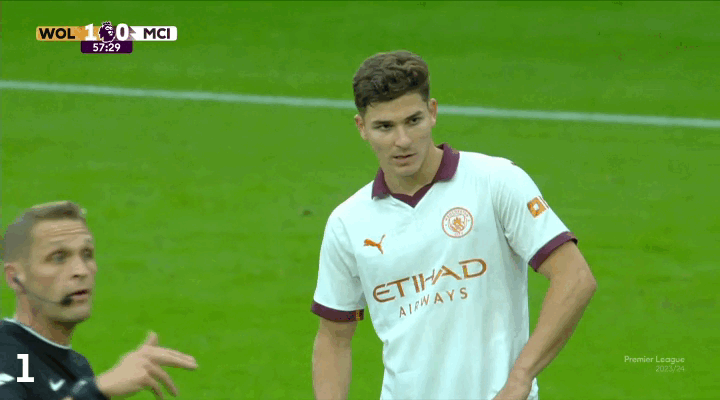
Crosstown rivals Manchester United have picked up on something of the same — here, against Tottenham Hotspur, Bruno Fernandes waits for the referee’s back to be turned before placing the ball down outside the foam line drawn on the grass.

Here, for City against Red Star Belgrade, it leads to a goal. Alvarez bends down and moves the ball around a foot to the right as the wall is being organised — which opens up space for Alvarez to drill the ball towards the far post without needing to worry about getting it over the wall. Goalkeeper Omri Glazer flaps at it and the ball nestles in the far corner.

Despite being known for maximising loopholes in the laws (check out their throw-in routines) and with their manager a disciple of Guardiola, Arsenal have not moved the ball once this season — but that is not to say they are not aware of the trick.
Arsenal send a spy towards the free kick spot — which cynically ensures it cannot be taken quickly and means they have a pair of eyes on any infraction. Here, Oleksandr Zinchenko performs the role, joking with Youri Tielemans as the Aston Villa midfielder attempts to lead him off.
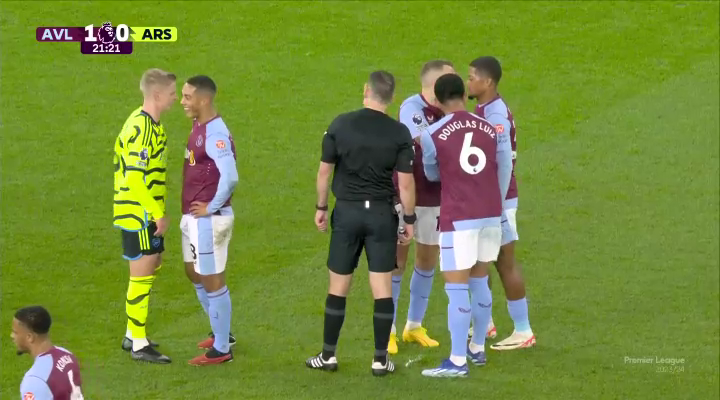
Cole Palmer, Chelsea’s free kick taker, is another who never engages in any dark arts — of all the takers in the league, his technique is the most simple. He puts the ball down very early, on the referee’s foam, runs up, and hits it.
But if he did choose to change that habit — he has not yet scored a professional free kick in his young career — there are three main techniques he might use. Given the limitations of space and time, all three are simple — forwards, backwards, sideways — but each of the three is used for a different reason.
The most common way to move the ball, counterintuitively, is backwards, away from the goal. This is usually seen close to the penalty area, where players want to get the ball up and down over the wall — moving it slightly backwards can make a significant difference, allowing the ball to take a far shallower trajectory.
Newcastle right-back Kieran Trippier has spoken publicly about using this to help with his free kicks. Against Everton last December, he made a show to referee Tim Robinson of putting the ball precisely on the spot, before rolling it slightly backwards — opening up the near post if he could use the space to beat the wall.

Take the most famous goal of Trippier’s career in the third minute of the 2018 World Cup semi-final against Croatia, where he does the same thing. The ball is initially directly over the mark, but late in the process, Trippier bends and rolls it backwards, as seen in the second slide below. His strike only clears the Croatian wall by five centimetres on its way into the net.

James Ward-Prowse, considered the best dead-ball specialist in the Premier League, is another to attempt this. Against Aston Villa, despite the VAR awarding a free kick right on the edge of the area, he places the ball down significantly outside the area. Though Matty Cash strides out the defensive wall to complain, referee David Coote lets Ward-Prowse take it from the new position.
Brighton’s Lewis Dunk and Crystal Palace’s Eberechi Eze are other players to have attempted to do this in 2023-24 — though referee Paul Tierney successfully policed the latter against Fulham last October.

Other players attempt to move the ball forward, especially when taking a shot from longer distances. There is, therefore, less need to get the ball up and down over a wall and more focus on accuracy and power.
Dominik Szoboszlai, here taking a set piece against Newcastle, sneaks an extra half-yard while the referee walks away, careful not to take too many liberties with Miguel Almiron watching on.

Luton Town’s Alfie Doughty might even credit the technique for the best goal of his career. Playing against Gillingham in the second round of this season’s Carabao Cup (this piece could be accused of snitching, but not of a lack of research), referee Jeremy Simpson seemingly points to the specific blade of grass he wants the ball situated on.
Team-mate Luke Berry pays no heed, rolling the ball forward slowly using the sole of his boot. By the time he stops, the original spot is under the boot of Pelly Ruddock Mpanzu. When Doughty receives a one-yard lay-off, he has gained around five yards — though his outstanding strike from long-range still might have gone in under any circumstances.
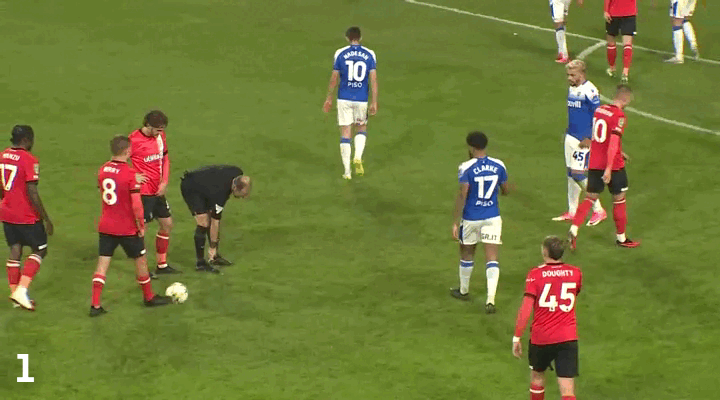
Toney’s goal was an example of lateral movement — players attempting to manipulate the ball’s location to minimise the wall’s impact or even to hide the goalkeeper’s view. Here, Eze moves the ball to the left to open up the left half of the goal.
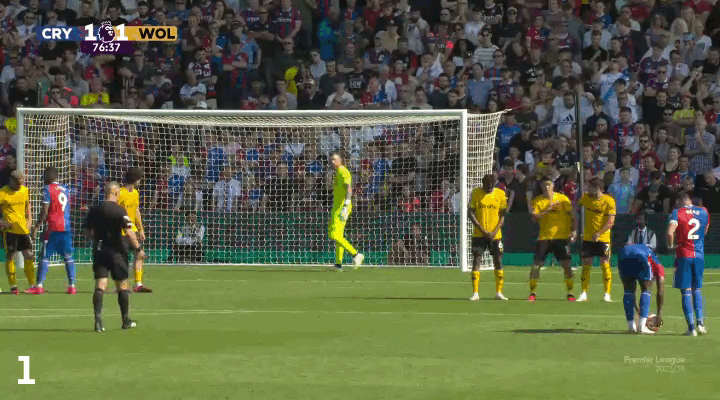
Villa’s Lucas Digne, another excellent free kick taker, here can be seen wiping around the foam before he moves the ball a foot to the left — it means he has to curl the ball left to exploit the fake wall his own team-mates have built.

The fact Toney moved the foam against Forest was a particular point of ruction — but he was not alone. As well as Toney, Niakhate for Forest, Digne for Villa, Trippier for Newcastle, and Yves Bissouma for Tottenham Hotspur have all done similar in the past 12 months.
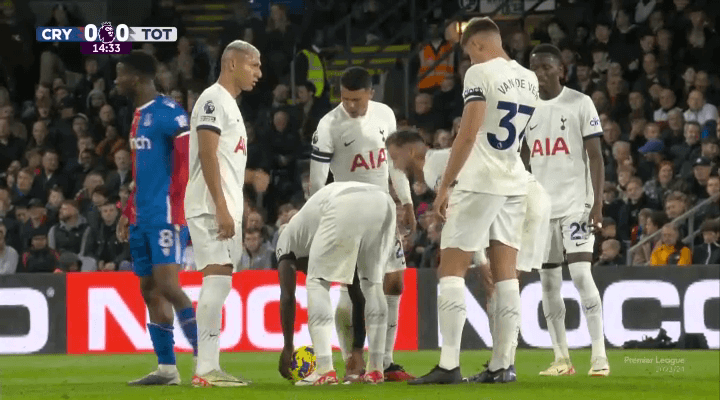
There is even an argument that, if they keep an eye on the taker, this gives the defence a clue. The taker’s actions in relation to the official spot indicate their intent — whether they want to go over the wall by moving it backwards or around the wall by shuffling to the side.
The rancour raised by Toney’s case is because of just one thing — he scored.
(Top photo: Wyscout)
Read the full article here


